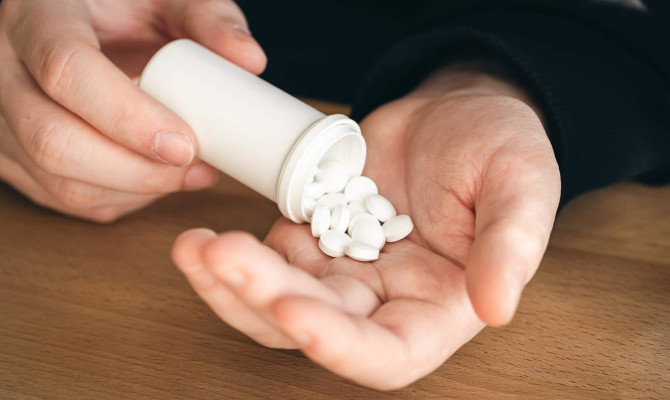Plaquenil: Uses, Side Effects, and Interactions

- Plaquenil
- 07 Sep 2023
Introduction
What is Plaquenil?
The drug hydroxychloroquine is a member of the class of treatments known as antimalarials (AMs), sometimes known as disease-modifying anti-rheumatic drugs (DMARDs). Plaquenil (hydroxychloroquine sulfate) is a white crystalline powder and is easily soluble in water but nearly insoluble in chloroform, alcohol, and ether. Plaquenil contains hydroxychloroquine. It can lessen arthritis pain and swelling, preventing joint degeneration and long-term impairment. The drug hydroxychloroquine is a member of a group of medications that were meant to prevent and treat malaria but are now the go-to treatment for lupus. Numerous additional autoimmune illnesses can benefit from its therapy. 1Introduction | Researched based study from American College of Rheumatology

Mode of Action
How does Plaquenil work?
- It is unknown exactly how Plaquenil works to prevent Plasmodium infections.
- Like chloroquine, Plaquenil is a weak base that can act by accumulating in the parasite’s acid vesicles and preventing heme from polymerizing.
- By interacting with DNA, it can also prevent some enzymes from functioning. 2Mode of Action | Researched based study from U.S. Food and Drug Administration
Indications
Uses of Plaquenil
Malaria:
- For the treatment of uncomplicated malaria caused by P. malariae, P. falciparum, P. vivax, and P. ovale, Plaquenil is recommended.
- In regions where there is no known chloroquine resistance, Plaquenil is recommended for the prevention of malaria.
Lupus Erythematosus:
- For the treatment of systemic and chronic discoid lupus erythematosus in adults, and lupus erythematosus, Plaquenil is recommended.
- Plaquenil is recommended in treating the adult patients with both chronic and acute rheumatoid arthritis. 4Indications | Researched based study from National Institutes of Health
Contraindications
Who should not consume Plaquenil?
- Patients with identified hypersensitivity to 4 aminoquinoline compounds should not use Plaquenil. 4Contraindications | Researched based study from National Institutes of Health
Dosage
Dosage
- The usual dosage of hydroxychloroquine is 6.5 milligrams per kilogram of weight of the person per day.
- Since Plaquenil comes in 200 mg tablets, many lupus patients who take it will take two of them daily.
- Those who have just received a lupus diagnosis can consume 400 mg once a day for a few weeks as the drug develops in their systems, followed by 200 to 400 mg once daily.
- Plaquenil can be given on alternate days or split into two tablets to reduce the daily dosage, account for low weight, or treat renal disease or failure.
- It is preferable to take Plaquenil with milk or food in order to minimize stomach distress. 3Dosage | Researched based study from Lupus Foundation of America
Storage
Storage Instructions
- Store the drug between 20 and 25 °C (68 and 77 °F), with excursions allowed between 15 and 30 °C (59 and 86 °F).
- Dispense Plaquenil in a light-resistant, and tightly sealed container.
- Maintain a safe distance from children. 2Storage | Researched based study from U.S. Food and Drug Administration
Administration
How is Plaquenil taken?
Plaquenil should be taken with food or a glass of milk.
For Malaria:
- Adults should take 400 mg every week on the same day starting two weeks before exposure and continuing for a period of four weeks after leaving an endemic area.
For Rheumatoid Arthritis:
- 400 mg to 600 mg is given as one dose per day or in two divided doses per day.
- A small percentage of individuals might need to temporarily reduce the initial dosage due to side effects.
For Lupus Erythematosus:
- Adults should take 200 to 400 mg daily, either in a single dose or two evenly spaced doses.
- Doses greater than 400 mg per day are not advised.
- If this maintenance dose is exceeded, retinopathy incidence has been found to increase. 4Administration | Researched based study from National Institutes of Health
Side Effects

What are the Side Effects of Plaquenil?
Cardiac Disorders:
- Cardiomyopathy, a condition that can lead to heart failure and, in some cases, death, is one type of cardiac illness. The QT interval is prolonged with Plaquenil.
Ear Disorders:
- Vertigo
- Ringing in the ear
- Hearing loss
- Ear and labyrinth illnesses
Eye Conditions:
- Maculopathies
- Poor dark adaptation
- Problems in color vision
- Irreversible retinopathy with retinal pigmentation changes
- Visual field defects
- Visual disturbances
- Corneal disposition of the drug
Musculoskeletal and Connective Tissues Disorders:
- Sensorimotor condition
- Skeletal muscle myopathy
- Neuropathy that causes proximal muscle groups to gradually weaken and atrophy, depresses tendon reflexes and causes aberrant nerve conduction.
Nervous System Issues:
This family of medications has been associated with reports of
- Headache
- Vertigo
- Seizures
- Ataxia
- Extrapyramidal diseases such as dystonia, dyskinesia, and tremor.
Psychiatry Disorders:
- Anxiety
- Irritability
- Nightmares
- Psychosis
- Suicidal behavior
Gastrointestinal Disorders:
- Abdominal pain
- Diarrhea
- Vomiting
- Nausea
General Disorders:
- Fatigue.
Hepatobiliary Disorders:
- Acute liver failure and abnormal liver function tests.
- Immune system problems include bronchospasm, angioedema, and urticaria.
Metabolism and Nutrition:
- Decreased hunger
- Hypoglycemia
- Porphyria
- Loss of weight 2Side Effects | Researched based study from U.S. Food and Drug Administration
Risks
Associated Risks
Malaria:
- Plaquenil is not efficient against P. falciparum that are resistant to chloroquine.
Ocular toxicity:
- Some patients who got Plaquenil had irreversible retinal damage.
- Daily doses of Plaquenil above 6.5 mg/kg depending upon the actual body weight, usage durations exceeding five years, abnormal glomerular filtration and concurrent macular disease are all major risk factors for retinal damage.
- The patient should be closely observed even after cessation of therapy.
- If ocular toxicity is suspected, it is advised that treatment with Plaquenil should be stopped, and the patient should be constantly monitored because retinal alterations may remain even after therapy is stopped.
Porphyria and Psoriasis:
- Psoriasis and porphyria can get worse when Plaquenil is used by psoriasis sufferers, who may have a severe flare-up of their condition.
- Using it on porphyria patients might make their condition worse.
- The preparation should not be used in these circumstances unless the doctor believes the patient would benefit more than any potential risks.
Cardiac Effects:
- Effects on the heart, such as prolongation of the QT interval and cardiomyopathy.
- Both the use of Plaquenil and the use of chloroquine have been linked to incidences of fatal and life-threatening cardiomyopathy.
- Patients may have cardiac problems, sick sinus syndrome, pulmonary hypertension, or atrioventricular block.
- Left or right bundle branch block is possible in ECG findings.
Neuropsychiatric Events:
- Suicidal behavior has only sometimes been documented in Plaquenil-treated patients.
Neuropathy & Proximal Myopathy:
- Skeletal muscle myopathies or neuropathies that cause proximal muscle groups to gradually weaken and atrophy have been linked to decreased tendon reflexes and aberrant nerve conduction.
Hypoglycemia:
- Plaquenil has been proven to produce severe hypoglycemia in people treated in combination with antidiabetic medicines, including loss of consciousness which may be life-threatening.
- It is important to inform patients receiving Plaquenil about the possibility of developing hypoglycemia as well as the accompanying clinical signs and symptoms. 2Risks | Researched based study from U.S. Food and Drug Administration
Precautions
Precautions
General:
- Patients with blood, digestive system, or neurological issues should use this medication with caution, as should anybody sensitive to quinine.
Liver or Kidney disease:
- Antimalarial drugs should be taken cautiously in people with chronic liver disease, or alcoholism, or when they are used with other medications that are known to be hepatotoxic.
- If patients get prolonged therapy, periodic blood counts should be done.
- When treating patients who have decreased glucose-6-phosphate dehydrogenase, Plaquenil should be used with caution.
- Patients with hepatic or renal dysfunction, as well as those taking medications known to have an impact on these organs, may require a dosage reduction.
Dermatologic Effects:
- Plaquenil may cause dermatologic reactions, so caution should be taken when giving it to any patient taking medication that has the propensity to cause dermatitis. 2Precautions | Researched based study from U.S. Food and Drug Administration
Pediatric Use:
- The long-term safety and effectiveness of using Plaquenil to treat juvenile idiopathic arthritis and systemic lupus erythematosus in children is unknown.
- Patients need to be firmly advised to keep Plaquenil away from children.
Lactation:
- Plaquenil should be administered to breastfeeding mothers with caution.
- Infants are known to be very vulnerable to the harmful effects of 4-aminoquinolines, and it has been shown that hydroxychloroquine given to nursing women is excreted in human milk.
Geriatric Use:
- The possibility of adverse reactions to Plaquenil may be higher in patients with poor renal function.
- Renal function should be monitored while giving a dose as the elderly people are more likely to have diminished renal function.
Overdose
Overdose
The 4-aminoquinoline molecules are entirely and quickly absorbed after consumption, and in rare cases with smaller amounts in hypersensitive people or unintentional overdose, hazardous symptoms may appear within 30 minutes.
The signs of an overdose may include –
- Headache
- Drowsiness
- Visual disturbances
- Collapse of the cardiovascular system
- Seizures
- Hypokalemia
- Conduction abnormalities
- Convulsions
Management of overdose
- Symptomatic treatment needs to happen quickly.
- It is advised to do prompt gastric lavage till the stomach is fully empty.
- Within 30 minutes of ingesting the medicine, activated charcoal may be delivered by the stomach tube to stop further intestinal absorption.
- As required, respiratory assistance and shock treatment should be implemented.
- Exchange transfusions are administered to lower the blood level of the medication 4-aminoquinoline.
- Forcing fluids and giving enough ammonium chloride for a few days to acidify the urine can be done. 2Overdose | Researched based study from U.S. Food and Drug Administration
Interactions
Drug Interactions
Diabetic Drugs or Insulin:
- Reduced doses of insulin or medications for diabetes may be necessary since Plaquenil could improve the therapeutic effects of a hypoglycemia treatment.
Digoxin:
- Serum levels of digoxin should be routinely monitored in patients undergoing concurrent Plaquenil and digoxin medication as they may increase.
Mefloquine:
- Mefloquine and other medications have been shown to decrease the convulsive threshold.
- Combining Plaquenil with additional antimalarial medications (such as mefloquine), which are known to reduce the convulsion threshold, could raise the risk of seizures.
Antiepileptics:
- If provided concurrently with Plaquenil, antiepileptic medication activity may be compromised.
Cyclosporine:
- When cyclosporine and Plaquenil were taken together, an elevated plasma cyclosporine level was noted.
Methotrexate:
- Combining methotrexate with Plaquenil has not been thoroughly investigated and could lead to more side effects.
- It should not be used with other medications that tend to cause cardiac arrhythmias.
- If Plaquenil is used concurrently with other medicines that cause ventricular arrhythmias, there may also be a higher likelihood of doing so. 4Interactions | Researched based study from National Institutes of Health
Any feedback on this article?
 This Articles content was accurate
This Articles content was accurate Very Informative Article
Very Informative Article I have a question or a comment
I have a question or a comment
 This article contains inaccurate content
This article contains inaccurate content This article was not helpful
This article was not helpful I have a question or a comment
I have a question or a comment
We appreciate your helpful feedback!
Checkout our social pages
References
-
American College of Rheumatology
Introduction
-
U.S. Food and Drug Administration
Mode of Action | Side Effect | Risks | Precautions | Storage | Overdose
-
Lupus Foundation of America
Dosage
-
National Institutes of Health
Indications | Administration | Contraindications | Interactions





































